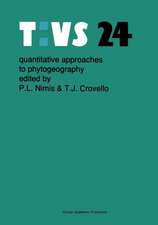Monitoring with Lichens - Monitoring Lichens: NATO Science Series: IV:, cartea 7
Editat de Pier Luigi Nimis, Christoph Scheidegger, Patricia A. Wolseleyen Limba Engleză Hardback – 31 ian 2002
| Toate formatele și edițiile | Preț | Express |
|---|---|---|
| Paperback (1) | 1223.11 lei 43-57 zile | |
| SPRINGER NETHERLANDS – 31 ian 2002 | 1223.11 lei 43-57 zile | |
| Hardback (1) | 1229.58 lei 43-57 zile | |
| SPRINGER NETHERLANDS – 31 ian 2002 | 1229.58 lei 43-57 zile |
Din seria NATO Science Series: IV:
- 18%
 Preț: 1225.94 lei
Preț: 1225.94 lei - 15%
 Preț: 640.06 lei
Preț: 640.06 lei - 18%
 Preț: 953.65 lei
Preț: 953.65 lei - 18%
 Preț: 950.84 lei
Preț: 950.84 lei - 18%
 Preț: 950.96 lei
Preț: 950.96 lei - 18%
 Preț: 948.61 lei
Preț: 948.61 lei - 18%
 Preț: 945.92 lei
Preț: 945.92 lei - 15%
 Preț: 644.63 lei
Preț: 644.63 lei - 18%
 Preț: 945.92 lei
Preț: 945.92 lei -
 Preț: 402.56 lei
Preț: 402.56 lei - 18%
 Preț: 1229.91 lei
Preț: 1229.91 lei - 15%
 Preț: 646.43 lei
Preț: 646.43 lei - 15%
 Preț: 647.08 lei
Preț: 647.08 lei -
 Preț: 394.51 lei
Preț: 394.51 lei - 18%
 Preț: 1230.21 lei
Preț: 1230.21 lei - 15%
 Preț: 657.57 lei
Preț: 657.57 lei - 18%
 Preț: 1835.83 lei
Preț: 1835.83 lei - 18%
 Preț: 1825.12 lei
Preț: 1825.12 lei - 18%
 Preț: 958.73 lei
Preț: 958.73 lei - 18%
 Preț: 951.29 lei
Preț: 951.29 lei - 18%
 Preț: 944.51 lei
Preț: 944.51 lei - 18%
 Preț: 1015.55 lei
Preț: 1015.55 lei - 15%
 Preț: 647.08 lei
Preț: 647.08 lei - 18%
 Preț: 1827.80 lei
Preț: 1827.80 lei - 18%
 Preț: 1835.53 lei
Preț: 1835.53 lei -
 Preț: 395.63 lei
Preț: 395.63 lei - 18%
 Preț: 944.99 lei
Preț: 944.99 lei
Preț: 1229.58 lei
Preț vechi: 1499.49 lei
-18% Nou
Puncte Express: 1844
Preț estimativ în valută:
235.35€ • 255.73$ • 197.83£
235.35€ • 255.73$ • 197.83£
Carte tipărită la comandă
Livrare economică 21 aprilie-05 mai
Preluare comenzi: 021 569.72.76
Specificații
ISBN-13: 9781402004292
ISBN-10: 140200429X
Pagini: 424
Ilustrații: IX, 408 p.
Dimensiuni: 155 x 235 x 28 mm
Greutate: 0.79 kg
Ediția:2002
Editura: SPRINGER NETHERLANDS
Colecția Springer
Seria NATO Science Series: IV:
Locul publicării:Dordrecht, Netherlands
ISBN-10: 140200429X
Pagini: 424
Ilustrații: IX, 408 p.
Dimensiuni: 155 x 235 x 28 mm
Greutate: 0.79 kg
Ediția:2002
Editura: SPRINGER NETHERLANDS
Colecția Springer
Seria NATO Science Series: IV:
Locul publicării:Dordrecht, Netherlands
Public țintă
ResearchCuprins
1. Monitoring with Lichens — Monitoring Lichens: An Introduction.- Section 1. Lichens as Indicators of Pollution.- 2. Monitoring Lichens as Indicators of Pollution: An Introduction.- 3. Bioindication: Calibrated Scales and their Utility.- 4. Bioindication: The I.A.P. Approach.- 5. Bioindication: The Community Approach.- 6. Accumulation of Inorganic Contaminants.- 7. Lichens as Monitors of Radioelements.- 8. Biomarkers of Pollution-Induced Oxidative Stress and Membrane Damage in Lichens.- 9. Key Issues in Designing Biomonitoring Programmes: Monitoring scenarios, sampling strategies and quality assurance.- Section 2. Monitoring Lichen Diversity and Ecosystem Function.- 10. Monitoring Lichen Diversity and Ecosystem Function: An Introduction.- 11. Methods for Monitoring Biodiversity and Ecosystem Function: Monitoring scenarios, sampling strategies and data quality.- 12. Monitoring Lichens for Conservation: Red Lists and Conservation Action Plans.- 13. Lichen Monitoring and Climate Change.- 14. Monitoring Biodiversity and Ecosystem Function: Forests.- 15. Monitoring Biodiversity and Ecosystem Function: Grasslands, Deserts, and Steppe.- 16. Monitoring Lichens on Monuments 239.- 17. Monitoring Maritime Habitats.- Section 3. Methods for Monitoring Lichens.- 18. Methods for Monitoring Lichens: An Introduction.- 19. Mapping Lichen Diversity as an Indicator of Environmental Quality.- 20. Identifying Deviations from Naturality of Lichen Diversity for Bioindication Purposes.- 21. Epiphytes on Wayside Trees as an Indicator of Eutrophication in the Netherlands.- 22. Using Lichens on Twigs to Assess Changes in Ambient Atmospheric Conditions.- 23. Guidelines for the Use of Epiphytic Lichens as Biomonitors of Atmospheric Deposition of Trace Elements.- 24. Transplanted Lichens forBioaccumulation Studies.- 25. Sample Preparation of Lichens for Elemental Analysis.- 26. Sulphur Isotopes in Lichens as Indicators of Sources.- 27. Estimation of Critical Levels of Air Pollution (Metals) on the Basis of Field Study of Epiphytic Lichen Communities.- 28. Monitoring Physiological Change in Lichens: Total Chlorophyll Content and Chlorophyll Degradation.- 29. Chlorophyll Fluorescence Measurements in the Field: Assessment of the Vitality of Large Numbers of Lichen Thalli.- 30. Measuring Bark pH.- 31. A Photographic Quadrat Recording Method Employing Image Analysis of Lichens as an Indicator of Environmental Change.- 32. Site Assessment of Epiphytic Habitats Using Lichen Indices.- 33. Indicator Species — Restricted Taxa Approach in Coniferous and Hardwood Forests of Northeastern America.- 34. Monitoring Regional Status and Trends in Forest Health with Lichen Communities: The United States Forest Service Approach.- 35. Biodiversity Assessment Tools — Lichens.- 36. Using Lichens and Bryophytes to Evaluate the Effects of Silvicultural Practices in Tasmanian Wet Eucalypt Forest.- 37. Using Corticolous Lichens of Tropical Forests to Assess Environmental Changes.- 38. Lichenometry.- 39. Transplanting Lichen Fragments for Provenance-Clone Tests.- 40. Assessing Changes in Density and Condition of Lichens for Species Recovery Programmes.- 41. Monitoring Red-Listed Lichens using Permanent Plots.- 42. A Method for Detecting Large-Scale Environmental Change with Lichens.


















